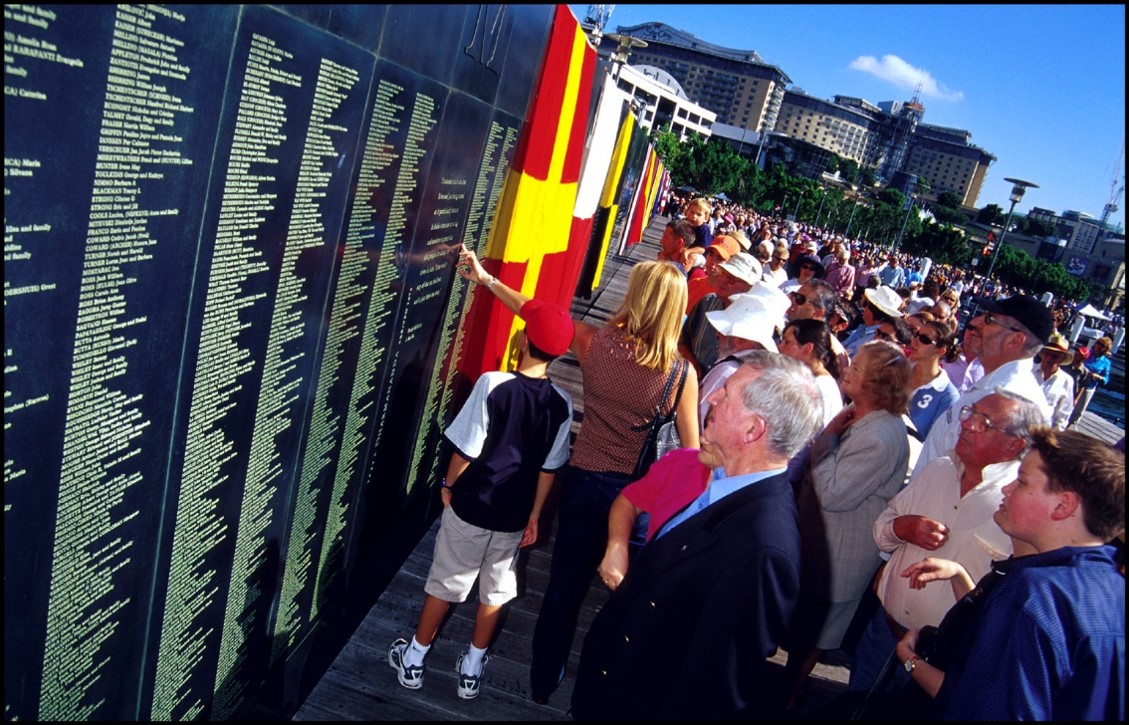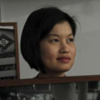
Australia’s national memorial to migration
Twenty years ago today, the first 3,000 names were officially unveiled on the museum’s Welcome Wall by then Governor-General Sir William Deane. Speaking at the launch on 24 January 1999, the Governor-General said, ‘Our nation is the sum of us all, all those who came here, all those who were born here, all those who are or have been Australian. And that is the great lesson of this Welcome Wall ... our diversity has led to our unity’. It is a message that remains as powerful and relevant as ever.
Today the Welcome Wall features nearly 30,000 names representing more than 100 countries. It is Australia’s only national memorial to one of history’s great migrations, in which more than 10 million people have crossed the seas to settle in Australia. Today around half of our population was either born overseas or has at least one parent born overseas.
Governor-General Sir William Deane walks with Children of the World to unveil the Welcome Wall, 1999. Photographer Andrew Frolows/ANMM.
Travellers and traders
The very first names inscribed on the Welcome Wall were Bernard Cowen and Harris Granat, who were part of the mass exodus of Jews from Tsarist Russia at the end of the 19th century. They were registered by their son and grandson, Sir Zelman Cowen, the distinguished legal academic who served as the 19th Governor-General of Australia from 1977 to 1982. Cowen was the second Jewish holder of the position after Sir Isaac Isaacs in the 1930s.
Bernard Cowen (1892–1975), a commercial traveller, was born in Pinsk, Belarus (then part of the Russian Empire) and moved to London with his family in 1903. He immigrated to Western Australia in 1911 and then settled in Victoria four years later. In 1918 Bernard married Melbourne-born Sara Granat (1893–1989), the daughter of Harris and Esther Granat from Mogilev, Belarus, who had arrived in Australia on Sommerfeld in 1891. Harris Granat worked for some years in Ballarat as a hawker of drapery and was a contemporary of another Russian draper from Mogilev, Simcha Baevski – better known as Sidney Myer, founder of the Myer department store.
Bernard and Sara’s only son, Zelman Cowen (1919–2011), was born and raised in St Kilda. Interested in ships from an early age, he enlisted in the Navy Reserve and was posted to Darwin at the time of the Japanese air raids in February 1942. In 1945 Zelman married Anna Wittner, the daughter of Hyman Wittner and Dora Melwit. Hyman Wittner was the son of a Romanian immigrant and established Wittner Shoes in Footscray in 1912, which today remains one of the oldest family businesses in Australia.
Convicts, migrants and refugees
From those first two names inscribed 20 years ago, the Welcome Wall has developed into a fascinating archive of personal stories and family histories. One of the wonderful things about the wall is that names are not inscribed in alphabetical order, or by date of arrival or country of origin, but in order of registration. This means that the names of British convicts and free settlers are interspersed with European displaced persons and Indochinese refugees, creating a powerful visual reflection of Australia’s cultural diversity.
Guests at the launch of the Welcome Wall, 1999. Photographer Andrew Frolows/ANMM.
Adjacent to the names of Bernard Cowen and Harris Granat is Henry Shiu-Lung Tsang (born 1943), whose family fled as refugees from China to Hong Kong following the Communist Revolution in 1949. Henry Tsang became the first Asian–Australian to be elected to the Council of the City of Sydney in 1991 and served as the city’s Deputy Lord Mayor until 1999. Further along the first panels is Irish farm labourer Patrick Deane, the great-grandfather of Sir William Deane (the Governor-General admitted he had submitted his registration form rather late in the piece). Patrick Deane arrived from Tipperary in 1851 and family legend has it that he disembarked from Harry Lorrequer in Sydney and saw a site advertising jobs. When he noticed the sign ‘No Irish’, he decided to get back on the ship and headed to Melbourne.
Entangled histories
The Welcome Wall records evocative personal anecdotes such as this one, while also revealing the richly entangled, intersecting histories of migration that have shaped Australia’s identity. One of my favourite narrative threads weaves together a tale of bonnets, bananas and department stores in Sydney and Shanghai.
In 1825 Anthony Hordern (1788–1869), a coach maker, and Ann Woodhead (c1791–1871), a bonnet and corset maker, emigrated from England and quickly founded prosperous businesses in Sydney. Their descendants established the Anthony Hordern & Sons department store, which by 1905 was the largest retail emporium in the southern hemisphere. Meanwhile Welsh draper David Jones arrived in 1835 and opened the first department store in Australia, which last year celebrated 180 years of continuous trading under the same name.
Three-storey building housing Wing Sang & Co and Hordern & Sons factory in Sussex Street, Sydney, 1910. Courtesy City of Sydney Archives NSCA CRS 51/2647.
In 1890 Gock Quay (1878–1916) arrived from southern China to join his older brothers, who owned the Wing On greengrocers in Sydney’s Haymarket. The Gocks were contemporaries of the Ma family, founders of the Wing Sang banana wholesalers. Using capital from their Sydney ventures, the Mas and the Gocks opened the Sincere and Wing On department stores in Shanghai in the early 1900s. Icons of modernity and Art Deco styling, the Shanghai stores were famously modelled on the architecture and practices of the flagship Sydney stores, David Jones and Anthony Hordern & Sons. This story is just one intriguing example of the web of interrelationships between names inscribed on the Welcome Wall.
Gock Quay (right) and his wife Rose Fok. Courtesy Paul Kwok.
New citizens, new Australians
Another strong narrative thread that connects people on the Welcome Wall is the Second World War and the Australian government’s post-war mass immigration program. In 1949, Magdalena (Leni) Janic (1925–2008) left her German homeland with her husband Ratko and baby son Bo, hoping that a new life in Australia would help to heal the scars of a childhood plagued by poverty and war. In Adelaide, Leni suffered from debilitating homesickness and the demands of assimilating into a culture in which the language, food and social customs were completely alien to her. Some weeks Leni had so little money left over that she couldn’t even afford a stamp to send a letter to her mother in Germany. It was her son that kept her going.
Leni Janic, with baby Bo, on her way to work at Philips Electrical Industries, Adelaide, early 1950s. Courtesy Annette Janic.
In 1957 Leni, Ratko and Bo became naturalised Australian citizens. Ratko shortened his name to Ray and some of Leni’s neighbours started to call her Madelaine. She regarded this as a welcome sign of the acceptance she had always longed for, now realised among new Australian friends who knew little about the turmoil of her past life in Europe. It’s a beautiful story to remember this week as we celebrate 20 years of the Welcome Wall, as well as the 70th anniversary of Australian citizenship law, which created for the first time the legal status of being uniquely Australian.
Leni Janic at her Australian naturalisation ceremony, Adelaide, 1957. Courtesy Annette Janic.
Leni Janic’s name was registered on the Welcome Wall by her daughter Annette, as a small show of appreciation for the immigrants who overcame alienation, isolation and deep-seated trauma to help shape our nation. As Annette says, their names should not be forgotten.
Welcome Wall registrations are temporarily on hold. You can register your interest here to be the first to hear when registrations re-open.
